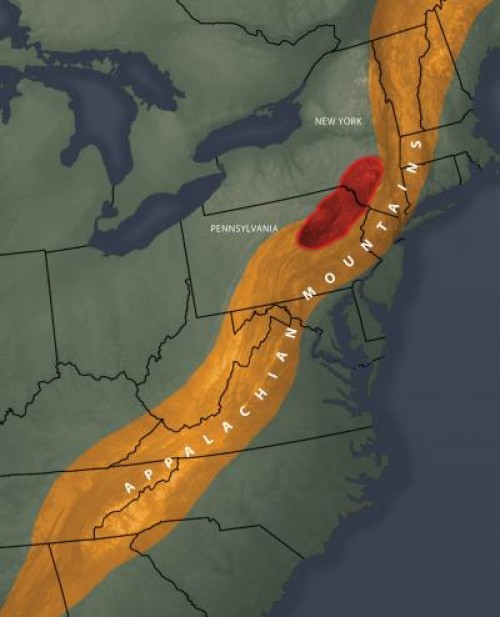The 1500 mile Appalachian mountain chain runs along a nearly straight line from Alabama to Newfoundland — except for a curious bend in Pennsylvania and New York State. Researchers from the College of New Jersey and the University of Rochester now know what caused that bend — a dense, underground block of rigid, volcanic rock forced the chain to shift eastward as it was forming millions of years ago.
According to Cindy Ebinger, a professor of earth and environmental sciences at the University of Rochester, scientists had previously known about the volcanic rock structure under the Appalachians. “What we didn’t understand was the size of the structure or its implications for mountain-building processes,” she said.
The findings have been published in the journal Earth and Planetary Science Letters.
When the North American and African continental plates collided more than 300 million years ago, the North American plate began folding and thrusting upwards as it was pushed westward into the dense underground rock structure — in what is now the northeastern United States. The dense rock created a barricade, forcing the Appalachian mountain range to spring up with its characteristic bend.

A dense, underground block of volcanic rock (shown in red) helped shape the well-known bend in the Appalachian mountain range.
Credit: Graphic by Michael Osadciw/University of Rochester.
The research team — which also included Margaret Benoit, an associate professor of physics at the College of New Jersey, and graduate student Melanie Crampton at the College of New Jersey — studied data collected by the Earthscope project, which is funded by the National Science Foundation. Earthscope makes use of 136 GPS receivers and an array of 400 portable seismometers deployed in the northeast United States to measure ground movement.
Benoit and Ebinger also made use of the North American Gravity Database, a compilation of open-source data from the U.S., Canada, and Mexico. The database, started two decades ago, contains measurements of the gravitational pull over the North American terrain. Most people assume that gravity has a constant value, but when gravity is experimentally measured, it changes from place to place due to variations in the density and thickness of Earth’s rock layers. Certain parts of Earth are denser than others, causing the gravitational pull to be slightly greater in those places.
Data on the changes in gravitational pull and seismic velocity together allowed the researchers to determine the density of the underground structure and conclude that it is volcanic in origin, with dimensions of 450 kilometers by 100 kilometers. This information, along with data from the Earthscope project ultimately helped the researchers to model how the bend was formed.
Ebinger called the research project a “foundation study” that will improve scientists’ understanding of Earth’s underlying structures. As an example, Ebinger said their findings could provide useful information in the debate over hydraulic fracturing — popularly known is hydrofracking — in New York State.
Hydrofracking is a mining technique used to extract natural gas from deep in the Earth. It involves drilling horizontally into shale formations, then injecting the rock with sand, water, and a cocktail of chemicals to free the trapped gas for removal. The region just west of the Appalachian Basin — the Marcellus Shale formation — is rich in natural gas reserves and is being considered for development by drilling companies.Note: Materials may be edited for content and length.



 July 24th, 2014
July 24th, 2014  Riffin
Riffin  Posted in
Posted in  Tags:
Tags: 